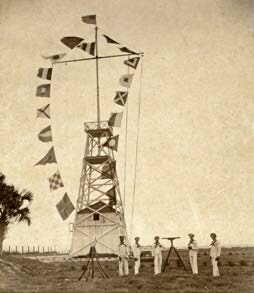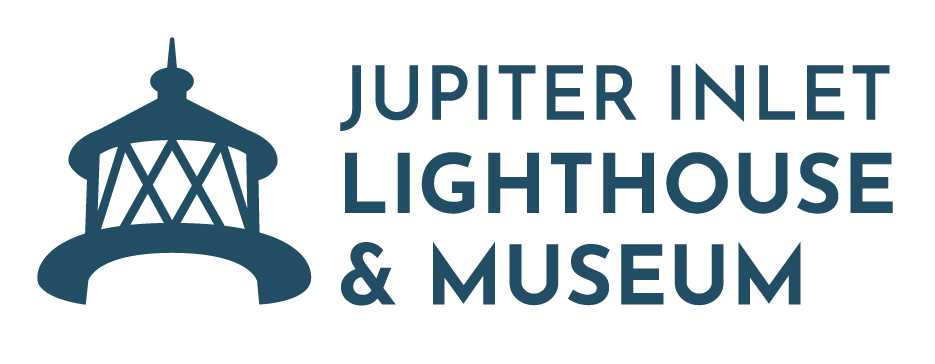The Untold Story of the Coast Signal Service at Jupiter Inlet Lighthouse
6 min read
In the annals of American history, the Spanish-American War of 1898 occupies a unique place, often remembered for the heroics of Theodore Roosevelt. However, behind the well-known battles, there existed an obscure yet crucial element of coastal defense: the Coast Signal Service. Let’s dive into the intriguing history of this little-known service and its significance to our local heritage.
The Beginning of the Coast Signal Service
The Spanish-American War was a brief but intense conflict that highlighted the need for efficient coastal defense mechanisms. In October 1897, anticipating the possibility of war with Spain, the Secretary of the Navy initiated the creation of the Coast Signal Service. This new service was designed to leverage existing lighthouse and lifesaving stations as lookout and communication points, effectively turning them into wartime signal stations. The cooperation of these civilian federal agencies, combined with the manpower from state naval militias, was vital for the success of this operation.

The only known photo of the Coastal Signal Service at Palm Beach Island. There are no known photos of when the station was active at Jupiter. (Courtesy of the Bradford-Eppes Family Collection, FSU Special Collections)
Florida's Strategic Importance
Florida’s extensive coastline made it a strategic location for the Coast Signal Service. The state had formed a naval militia in the summer of 1897, positioning itself to play a significant role. Captain Caspar F. Goodrich of the U.S. Navy was tasked with developing and implementing the plan for the Coast Signal Service along the Atlantic and Gulf Coasts. By March 1898, as tensions escalated following the explosion of the USS Maine in Havana Harbor, Goodrich had laid out a detailed plan, which included the establishment of signal stations at key points along Florida’s east coast.
Establishing the Stations
One of the key stations established was at the Jupiter Inlet. The site, already home to the Jupiter Lifesaving Station where Carlin Park is today, was an ideal location. The existing infrastructure provided barracks space and a lookout tower, while a new 90-foot wooden signal mast was erected. The lifesaving station keeper, Charles R. Carlin, played a crucial role in the transition, overseeing the adaptation of the station to its new dual purpose.
Another station was set up at Cape Canaveral, one of the most remote and challenging locations. With no direct telegraph connection, couriers had to travel significant distances to relay messages. Similarly, Cape Florida Lighthouse, though inactive for two decades, was repaired and equipped to serve as a signal station.
The Challenges of Communication
One of the significant challenges faced by the Coast Signal Service was communication. None of the Florida stations were initially connected to telegraph lines, a critical component for timely and effective communication. Jupiter Inlet was slightly better positioned, being located on the mainland and relatively close to a Western Union office. However, reestablishing a direct communication line proved challenging due to logistical errors, such as the misdelivery of telephone equipment to a town called Juniper instead of Jupiter.
Cape Canaveral, on the other hand, required a 15-mile bicycle ride followed by a boat trip across the Indian River to reach the nearest telegraph. Cape Florida necessitated a boat journey across Biscayne Bay to Miami. These logistical hurdles underscored the difficulties of maintaining an efficient communication network during wartime.
The Role of Semaphore and Spyglasses
Without modern communication tools, the Coast Signal Service relied on semaphore flags to communicate with passing ships using International Code. The signalmen were trained to read Navy Code flags, enabling them to receive and forward confidential messages to Washington, D.C. Despite the challenges, the service managed to equip the stations with the necessary spyglasses, binoculars, and signaling equipment, albeit at a slower pace.
An interesting episode occurred when the USS Oregon arrived off Jupiter Inlet. The battleship, having left California before the activation of the Coast Signal Service, was unaware of the new station’s existence. This led to a mix-up where the ship sent a landing party to the Weather Bureau Station instead of communicating with the Coast Signal Station.
Relocation to Palm Beach
In June 1898, the Coast Signal Service decided to move the Jupiter station to Palm Beach Island, near the Palm Beach Inn (now the Breakers Hotel). The East Coast Hotel Company generously provided the grounds and a nearby house for the station, along with a connection to the hotel’s telegraph line, enhancing the station’s communication capabilities.
The End of the Coast Signal Service
The U.S. Navy’s decisive defeat of the Spanish fleet off Santiago, Cuba on July 3 effectively ended any need to continue the Coast Signal Service. By August, the Palm Beach station was decommissioned, and its equipment handed over to the hotel company. Despite its brief existence, the Coast Signal Service proved invaluable in testing and improving coastal defense strategies.
Legacy and Impact
The success of the Coast Signal Service during the Spanish-American War set a precedent for future coastal defense efforts. In World War I, Navy signalmen were stationed at major lighthouses, including the Jupiter Weather Bureau Station. During World War II, the integration of the Lighthouse Service and Lifesaving Service into the Coast Guard further cemented the role of coastal stations as vital lookout posts.
Preserving History at Jupiter Inlet Lighthouse & Museum
Today, the Jupiter Inlet Lighthouse & Museum stands as a testament to this rich history. Operated by the Loxahatchee River Historical Society, the museum preserves and interprets the unique historical, cultural, and natural characteristics of the Loxahatchee River region. The museum’s exhibits offer a comprehensive view of the region’s maritime history and the evolution of coastal defense mechanisms over the years.
Conclusion: A Legacy Remembered
The story of the Coast Signal Service is a compelling chapter in the history of the Jupiter Inlet Lighthouse & Museum. It is a tale of innovation, dedication, and resilience, set against the backdrop of a nation at war. We honor the legacy of those who served and the enduring impact of their contributions. Join us to explore this rich history and ensure that the stories of the past continue to inspire future generations.
FAQs
What was the primary purpose of the Coast Signal Service during the Spanish-American War?
The Coast Signal Service was established to use existing lighthouse and lifesaving stations as lookout and communication points to detect and report enemy ship movements along the coast.
How were messages communicated from the Coast Signal Stations?
Messages were communicated using semaphore flags and spyglasses. The stations were eventually equipped with telegraph lines for quicker communication with naval headquarters.
Why was the Jupiter station moved to Palm Beach?
The Jupiter station was moved to Palm Beach to improve communication capabilities, leveraging the proximity to the Palm Beach Inn’s telegraph line.
What happened to the Coast Signal Service after the Spanish-American War?
The Coast Signal Service was decommissioned after the war. However, its success influenced future coastal defense strategies during World War I and World War II.
How can visitors learn more about the Coast Signal Service?
Visitors can learn more by exploring exhibits at the Jupiter Inlet Lighthouse & Museum, attending special events like Loxahatchee River Heritage Day, and participating in guided tours.
